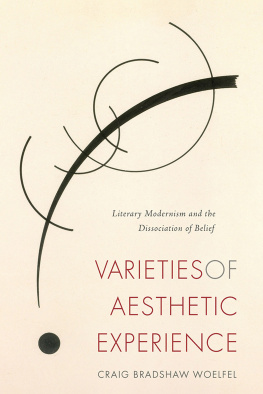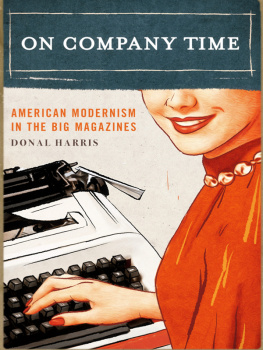
Varieties of Aesthetic Experience
Varieties of
Aesthetic Experience
Literary Modernism and the Dissociation of Belief
Craig Bradshaw Woelfel

The University of South Carolina Press
2018 University of South Carolina
Published by the University of South Carolina Press
Columbia, South Carolina 29208
www.sc.edu/uscpress
27 26 25 24 23 22 21 20 19 18
10 9 8 7 6 5 4 3 2 1
Library of Congress Cataloging-in-Publication data
can be found at http://catalog.loc.gov/.
ISBN 978-1-61117-905-7 (hardback)
ISBN 978-1-61117-906-4 (ebook)
Front cover illustration: Free Curve to the PointAccompanying Sound of
Geometric Curves, 1925, by Vasily Kandinsky, courtesy of Open Access at
The Met, the Metropolitan Museum of Art
To Lindsay
amabat amat.
Contents
Acknowledgments
Thanks first to those at UC San Diego who first helped get this book startedespecially Richard Cohen, who showed me what real religious studies scholarship was; and Michael Davidson, who helped me in ways it has taken me over a decade to understand and appreciate. Thanks to everyone at Notre Dame who gave me guidance and support as the project took real shapeRomana Huk and Maud Ellmann, Christian Moevs, the Devers Program in Dante Studies, Religion and Literature, Susannah Monta; and Steve Fredman, who, like Statius, has that rarest of teachers gifts: knowing how to lead from behind and carrying the light with him for when it is needed. Thanks to the T. S. Eliot Society, for cultivating a community where this project could grow through the best form of scholarly work: friendly conversationto Dominic Manganiello, a model of intellectual generosity since the day I met him; John Morgenstern, who gave me invaluable advice along the way; and Tony Cuda, whose small encouragement almost ten years ago in Florence legitimized the project, and whose subsequent criticism and friendship have seen it through. Thank you to Doug McFarland, who righted my will and is this books honorary coauthor. Thanks go to the manuscripts first reader, Jeff Johnson, il miglior amigo.
An earlier version of part of .
Reprint permission granted for material from by the University of Notre Dame, Religion & Literature 44.1 (Spring 2012).
Modernist Literature and the
Dissociation of Belief
A minor addition to the catalog of modernisms great annus mirabilis: E. M. Forster and T. S. Eliot almost spent a lovely weekend together in May 1922. Lady Ottoline Morrell had extended Forster an invitation to come to Garsington for a weekend. For Forster, it was a move out of his normal Bloomsbury circle into another realm, that of the London high modernist literary scene. He was given the choice by his hostess of a first meeting with either Eliot or Wyndham Lewis. He chose the latter. Forsters biographer has related that he and Lewis got on amicablythey escaped from a crowd of overzealous undergrads by means of a long walk, one of Forsters favorite activities. However, he found the weekend of high society rather intrusive, and resented in particular Lady Ottolines fishing for confidences about his recently deceased lover, Mohammed el Adl.
Eliots and Forsters careers nearly met once more five years later, though again their persons did not. But as he stood to begin, he was thinking not of his future as a novelist but of the shadow his critic-predecessor cast over the occasion:
Let me quote here for our comfort from my immediate predecessor in this lectureship, Mr. T. S. Eliot. Mr. Eliot enumerates, in the introduction to The Sacred Wood, the duties of the critic. It is part of his business to preserve traditionwhen a good tradition exists. It is part of his business to see literature steady and to see it whole; and this is eminently to see it not as consecrated by time, but to see it beyond time. The first duty we cannot perform, the second we must try to perform. We can neither examine nor preserve tradition. But we can visualize the novelists as sitting in one room, and force them, by our very ignorance, from the limitations of date and place. I think that this is worth doing, or I should not have ventured to undertake this course.
Eliot had given the lectures in 192526, an honor that would help establish him in the role of his generations definitive critic. The conscious attempt by both to see literature steady and to see it whole produced from the back-to-back lectures two monumental summary works on aesthetics: Forsters Aspects of the Novel, published in 1927; and Eliots The Varieties of Metaphysical Poetry. Eliot had originally intended the lectures to net three books, but they would not in fact produce any until the lectures themselves were published in 1993, under the editorial guidance of Ronald Schuchard. Eliots lectures are his most comprehensive historicization of literary and intellectual history, and they served to codify his influential theory of the dissociation of sensibility as well as his classicist position. Forsters criticism has sadly not been much remembered by critics. But Forster was not chosen by accident; the lectures are remarkable. They more than hold their own with Eliots not only in scope and insight but also in their penetrating treatment of key modernist aesthetic themes. Where they differ most greatly is in tone: Forsters reference to Eliot for our comfort is emblematic of his accommodating humility and charm as a speaker, and a world apart from the pedantic esotericism that made Eliot seem so masterful. He would not mention Eliot again.
The year 1926 was when T. S. Eliot entered St. Peters in Rome and, to the surprise of his brother and sister-in-law who were with him, fell to his knees in prayer before Michelangelos Piet. Eliot was mired in a period of mental and emotional breakdownone of several he underwent over the first half of his life and to which his brother was often privy. His letters suggest that this breakdown can be traced back to around 1925that is, when Eliot was writing his own Clark Lecturesand a series of compounding causes: the near-deadly illness of his first wife, Vivien, and the continuing deterioration of their marriage; personal and financial stress over his pending decision to leave Lloyds Bank and to relaunch the Criterion; and, surely not least, simple overwork. He who desires to be a competent banker, a powerful literary magazine editor, and the most influential poet-critic in English letters burns the candle at both ends. So it was not the collapse itself but its spiritual nature that was cause for surprise. Less than one year later, on 29 June 1927, Eliot was baptized in the Church of England. In November he would take the oath of British citizenship, and a transformation of multiple sorts would seem to be complete.
If his family was surprised, his fellow modernists were shocked.
After 1927 Eliot worked increasingly to incorporate his beliefs into his art and criticism, and he separated himself in matters of politics, art, and faith from the views of his former coterie. The radical modernist poet of The Waste Land turned conservative figurehead, or as he soon would (in)famously put it in the preface to For Lancelot Andrewes: Classicist, Royalist, and Anglo-Catholic. Forster, meanwhile, moved out along an opposite trajectory. After the publication of A Passage to India he became an active public supporter of the spread of liberal democratic politics, as well as a skeptical variety of humanism that included a consistent vocal rejection of various dimensions of organized religion. He had lost his faith as an undergrad at Cambridge; his famous 1938 essay What I Believe opens with his declaration that he did not believe in belief, and at age eighty he would tell his audience of the Cambridge Humanists that he feared only that a Humanism which [had] been gained so softly may not stand [him] in the hour of death, though he would be glad if it did.
Next page





